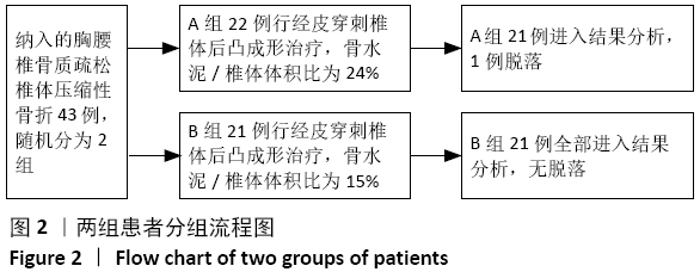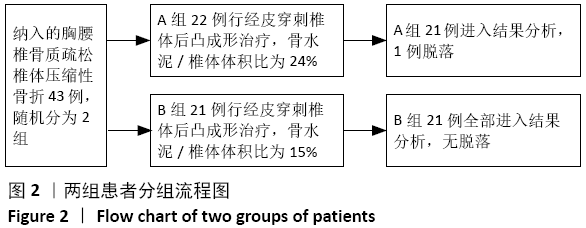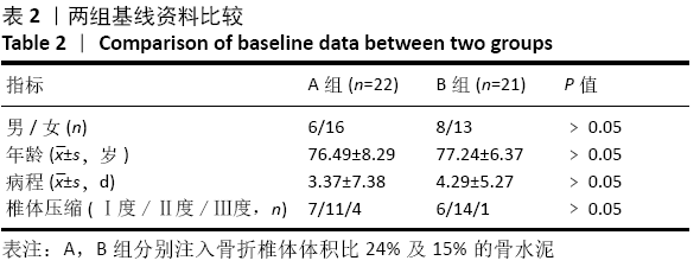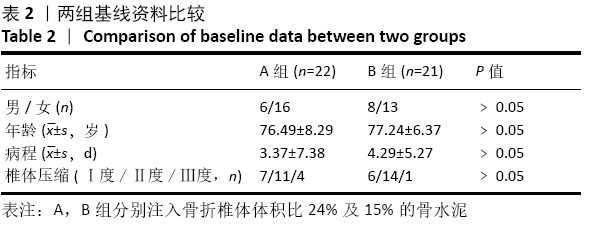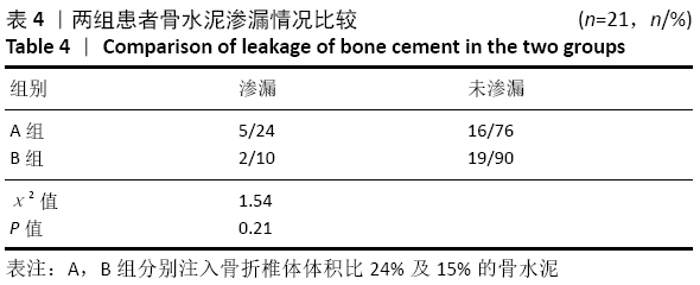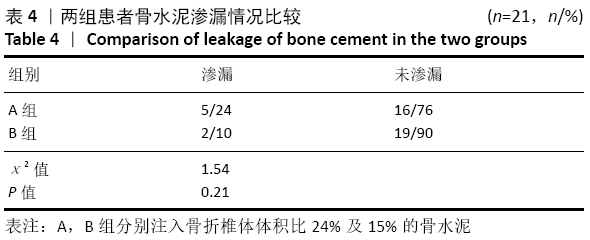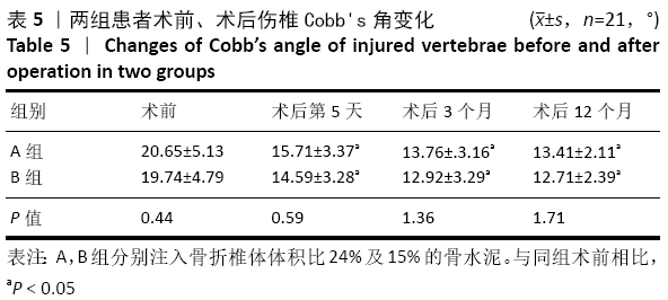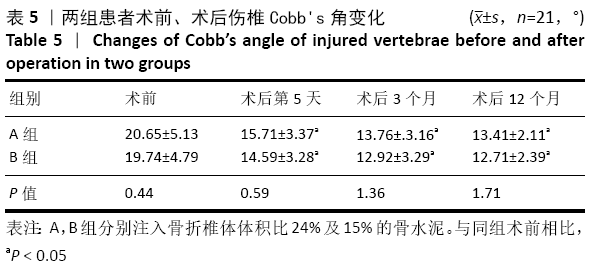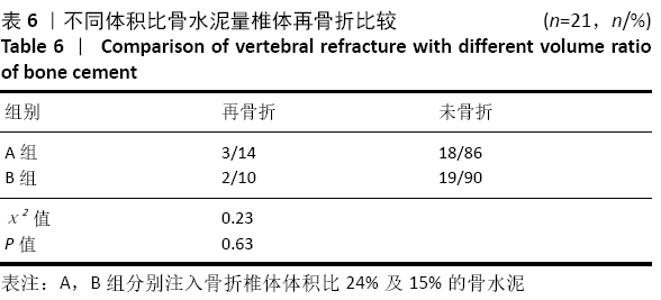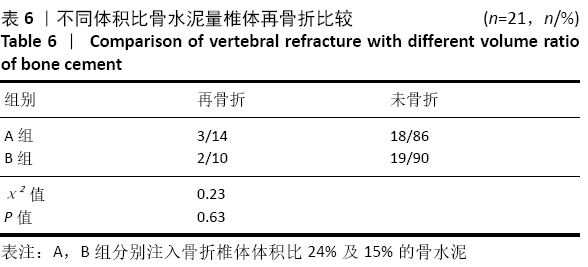Chinese Journal of Tissue Engineering Research ›› 2021, Vol. 25 ›› Issue (10): 1482-1488.doi: 10.3969/j.issn.2095-4344.3028
Previous Articles Next Articles
Safety dose of bone cement in vertebroplasty assessed by Mimics software
He Renjian, Yu Chao, Luo Yuanchao, Liu Xu, Yang Fuguo
- Department of Orthopedics, Zigong First People’s Hospital, Zigong 643000, Sichuan Province, China
-
Received:2019-12-23Revised:2019-12-28Accepted:2020-02-26Online:2021-04-08Published:2020-12-17 -
Contact:Yang Fuguo, Master, Department of Orthopedics, Zigong First People’s Hospital, Zigong 643000, Sichuan Province, China -
About author:Department of Orthopedics, Zigong First People’s Hospital, Zigong 643000, Sichuan Province, China -
Supported by:the Scientific Research Fund Project of Sichuan Health Department, No. 18PJ481 (to HRJ)
CLC Number:
Cite this article
He Renjian, Yu Chao, Luo Yuanchao, Liu Xu, Yang Fuguo. Safety dose of bone cement in vertebroplasty assessed by Mimics software[J]. Chinese Journal of Tissue Engineering Research, 2021, 25(10): 1482-1488.
share this article
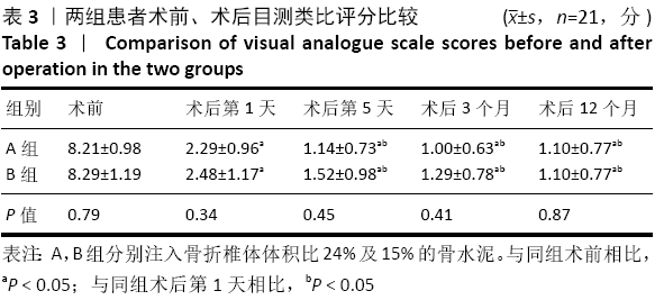
2.4 手术及骨水泥注射情况 43例患者均成功完成手术。A组中1例T6因穿刺位置较高,手术风险较大,致骨折椎体外侧骨皮质破坏骨水泥渗漏,未能达到预定的骨水泥24%体积比,但术后疼痛缓解,胸椎活动功能明显恢复,故将其排除,其余21例患者均按24%体积比注射骨水泥,平均骨水泥量为(4.6±0.7)mL;B组21例患者均按照术前预定15%体积比注射骨水泥,平均骨水泥量为(2.9±0.3)mL。 2.5 疼痛缓解情况 目测类比评分方面,两组患者术后各时点与术前相比,术后第1天与术后第5天(出院前)、3个月、12个月相比,差异均有显著性意义(P < 0.05);其中术后第5天(出院前)、第3个月、第12个月之间比较疼痛程度差异无显著性意义(P > 0.05);A、B两组之间术后第1天、第5天(出院前)、第3个月、第12个月疼痛程度比较,差异无显著性意义(P > 0.05),见表3。 "
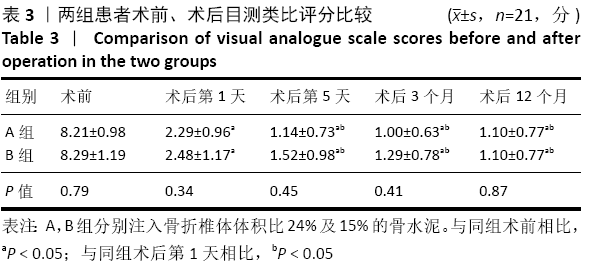
| [1] 李楠,张贵林,何达,等.骨水泥的分布与剂量对椎体成形术疗效影响的研究[J].中国骨与关节损伤杂志,2015,30(1):66-68. [2] LI YA, LIN CL, CHANG MC, et al. Subsequent vertebral fracture after vertebroplasty: incidences and analysis of risk factors. Spine. 2012; 37(3): 179-183. [3] NIEUWENHUIJSE MJ, BOLLEN L,VAN ERKEL AR, et al. Optimal intravertebral cement volume in percutaneous vertebroplasty for Painful osteoporotic vertebral compression fractures. Spine. 2012; 37(20): 1747-1755. [4] LA MAIDA GA, GIARRATANA LS, ACERBI A, et al. Cement leakage: safety of minimally invasive surgical techniques in the treatment of myeloma vertehral lesions. Eur Spine J. 2012;1:61-68. [5] LIEBSCHNER MA, ROSENBERG WS, KEAVENY TM. Effects of bone cement volume and distribution on vertebral stiffness after vertebroplasty. Spine. 2001; 26(14) :1547-1554. [6] YANG B, FANG SB, LI CS, et al. Digital Three-Dimensional Model of Lumbar region 4-5 and Adjacent Structures Based on a virtual Chinese human. Orthop Surg. 2013;5(2):130-134. [7] 杨波,方世兵,唐雷,等.数值化虚拟腰椎的三维重建及可视化研究[J].中华骨科杂志,2013,33(1):71-75. [8] 中国医师协会骨科学分会脊柱创伤专业委员会.急性症状性骨质疏松性胸腰椎压缩骨折椎体强化术临床指南[J].中华创伤杂志, 2019,35(6):481-489. [9] 杨惠林,刘强,唐海,等.骨质疏松性椎体压缩性骨折患者抗骨质疏松规范治疗专家共识[J].中华医学杂志,2018,98(11):803-807. [10] WANG G, YANG H, CHEN K. Osteoporotic vertebral compression fractures with an intravertebral cleft treated by percutaneous balloon kyphoplasty. J Bone Joint Surg Br. 2010;92(11):1553-1557. [11] 杨惠林,胡侦明,邱贵兴,等.经皮椎体成形术治疗的相关建议[J]. 中华骨与关节外科杂志,2015,8(5):375-376. [12] KALLMES DF, COMSTOCK BA, HEAGERTY PJ, et al. A randomized trial of vertebroplasty for osteoporotic spinal fractures. N Engl J Med. 2009; 361(6):569-579. [13] BUCHBINDER R, OSBORNE RH, EBELING PR, et al. A randomized trial of vertebroplasty for painful osteoporotic vertebral fractures. N Engl J Med. 2009;361(6):557-568. [14] KLAZEN CA , LOHLE PN , DE VRIES J ,et al. Vertebroplasty versus conservative treatment in acute osteoporotic vertebral compression fractures (Vertos II): an open-label randomised trial. Lancet . 2010; 376 (9746): 1085-1092. [15] CLARK W, BIRD P, GONSKI P, et al. Safety and efficacy of vertebroplasty for acute painful osteoporotic fractures (VAPOUR): a multicentre, randomised, double-blind, placebo-controlled trial. Lancet . 2016; 388 (10052): 1408-1416. [16] WARDLAW D, CUMMINGS SR, VAN MEIRHAEGHE J, et al. Efficacy and safety of balloon kyphoplasty compared with non-surgical care for vertebral compression fracture (FREE): a randomised controlled trial. Lancet. 2009; 373 (9668): 1016-1024. [17] SAXENA BP, SHAH BV, JOSHI SP. Outcome of percutaneous balloon kyphoplasty in vertebral compression fractures. Indian J Orthop. 2015; 49(4):458-464. [18] ZAPAŁOWICZ K, RADEK M. Percutaneous balloon kyphoplasty in the treatment of painful vertebral compression fractures: effect on local kyphosis and one-year outcomes in pain and disability. Neurol Neurochir Pol. 2015; 49(1):11-15. [19] CHEN AT,COHEN DB,SKOLASKY RL. Impact of nonoperative treatment, vertebroplasty, and kyphoplasty on survival and morbidity after vertebral compression fracture in the medicare population. J Bone Joint Surg (Am). 2013; 95(19):1729-1736. [20] 黎双庆,杨波,杨逸禧,等.经皮穿刺椎体成形术治疗骨质疏松性严重椎体压缩性骨折[J].中国微创外科杂志,2015,15(9):818-821. [21] 陈建常,王鑫,马在松,等.骨质疏松患者PVP/PKP术后新发椎体压缩性骨折相关危险因素[J].中国矫形外科杂志,2015,23(10): 902-907. [22] KAUFMANN TJ,TROUT AT,KALLMES DF. The effects of cement volume on clinical outcome of percutaneous vertebroplasty. AJNR Am J Neuroradiol. 2006; 27 (9) :1933-1937. [23] 苟永胜,李海波,何小翠,等.骨水泥注射量与经皮椎体后凸成形术后疗效的临床随机对照研究[J]. 中国骨与关节损伤杂志,2015, 30(5):473-476. [24] LUO J, DAINES L, CHARALAMBOUS A, et al. Vertebroplasty: only small cement volumes are required to normalize stress distributions on the vertebral bodies.Spine. 2009;34(26):2865-2873. [25] YAN L , CHANG Z , XU Z, et al. Biomechanical effects of bone cement volume on the endplates of augmented vertebral body: a three-dimensional finite element analysis. Chin Med J (Engl). 2014;127(1): 79-84. [26] 江晓兵,黄伟权,庞智晖,等. 基于Mimics软件计算椎体强化术后椎体内骨水泥体积及骨水泥/推体体积比的新方法[J].中国脊柱脊髓杂志,2013,23(3):238-243 [27] MOUSAVI P, ROTH S, FINKELSTEIN J, et al. Volumetric quantification of cement leakage following percutaneous vertebroplasty in metastatic and osteoporotic vertebrae. J Neurosurg. 2003;99 (1 Suppl): 56-59. [28] KOMEMUSHI A, TANIGAWA N,KARIYA S, et al. percutaneous vertebroplasty for compression fracture:analysis of verterbral body by CT volumetry. Acta Radiol. 2005;46(3):276-279. [29] JIN YJ, YOON SH, PARK KW, et al. The volumetric analysis of cement in vertebroplasty: relationship with clinical outcome and complications. Spine(Phila Pa 1976). 2011;36(2):E761-E762. [30] NIEUWENHUIJSE MJ, BOLLEN L, VAN ERKEL AR, et al. Optimal intravertebral cement volume in percutaneous vertebroplasty for painful osteoporotic vertebral compression fractures. Spine(Phila Pa 1976). 2012;37(20):1747-1755. [31] KWON HM, LEE SP, BAEK JW, et al. Appropriate cement volume in vertebroplasty: a multivariate analysis with short-term follow-up. Korean J Neurotrauma. 2016;12(2):128-134. [32] 唐龙,杨波,章波,等.数字骨科学在微创治疗严重OVCF中临床应用[J].中国数字医学,2015,10(1):61-63. [33] 杨惠林.经皮椎体强化术的临床应用[J].骨科,2017,8(3):161-162. [34] SONG D, MENG B, GAN M, et al. The incidence of secondary vertebral fracture of vertebral augmentation techniques versus conservative treatment for painful osteoporotic vertebral fractures: a systematic review and meta analysis. Acta Radiol. 2015;56(8):970-979. [35] TAYLOR RS, FRITZELL P, TAYLOR RJ. Balloon kyphoplasty in the management of vertebral compression fractures: an updated systematic review and meta-Analysis. Eur Spine J. 2007;16(8): 1085-1100. [36] TROUT AT, KALLMES DF. Does vertebroplasty cause incident vertebral fractures?A review of available data. AJNR Am JNeuroradiol. 2006; 27(7):1397-1403. [37] POLIKEIT A, NOHE LP, FERGUSON SJ. The effect of cement augmentation on the load transfer in an osteoporotic functional spinal unit: finite-element analysis. Spine(Phila Pa 1976). 2003;28(10): 991-996. [38] 张煜,张绍东.椎体成形术后手术椎体再塌陷的危险因素[J].中国脊柱脊髓杂志,2016,26(5):459-462. |
| [1] | Shu Qihang, Liao Yijia, Xue Jingbo, Yan Yiguo, Wang Cheng. Three-dimensional finite element analysis of a new three-dimensional printed porous fusion cage for cervical vertebra [J]. Chinese Journal of Tissue Engineering Research, 2021, 25(24): 3810-3815. |
| [2] | Zhou Yuanbo, Wang Jindong. Etiology and treatment of femoral trochlear dysplasia: congenital genetic determination or stress stimulation of patella [J]. Chinese Journal of Tissue Engineering Research, 2021, 25(24): 3908-3913. |
| [3] | Cai Qunbin, Yang Lijuan, Li Qiumin, Chen Xinmin, Zheng Liqin, Huang Peizhen, Lin Ziling, Jiang Ziwei . Feasibility of internal fixation removal of intertrochanteric fractures in elderly patients based on fracture mechanics [J]. Chinese Journal of Tissue Engineering Research, 2021, 25(21): 3313-3318. |
| [4] | Wu Yanyu, Zhang Chunlin, Shao Chenglong, Yan Xu, Liu Xiaokang, Wang Yongkui, Li Dongzhe. Quantitative measurement of resorption of cervical herniated disc after cervical microendoscopic laminoplasty by two-dimensional distance method and three-dimensional volume method [J]. Chinese Journal of Tissue Engineering Research, 2021, 25(21): 3390-3394. |
| [5] | Li Yuanyuan, Lu Yingjuan, Ye Yushan, Mustafa M.M Weldali, Chang Shaohai. Constructing finite element models of three maxillary arch forms [J]. Chinese Journal of Tissue Engineering Research, 2021, 25(20): 3125-3129. |
| [6] | Du Xueting, Yang Yang, Huang Wenhua, Chen Wubiao. Clinical application and breakthrough of three-dimensional printing based on medical imaging technology [J]. Chinese Journal of Tissue Engineering Research, 2021, 25(18): 2887-2894. |
| [7] | Chen Xiaolong, Zhao Heng, Hu Rong, Luo Guanghua, Liu Jincai . Correlation of infrapatellar fat pad edema with trochlear and patellofemoral joint morphology: MRI evaluation [J]. Chinese Journal of Tissue Engineering Research, 2021, 25(15): 2410-2415. |
| [8] | Shu Hui, Huang Xiaowei. Different configurations of anterior double-plate fixation in types B and C of sacroiliac joint dislocation: a finite element analysis [J]. Chinese Journal of Tissue Engineering Research, 2021, 25(12): 1810-1814. |
| [9] | Liu Zhengpeng, Wang Yahui, Ming Ying, Sun He. Computer design combined with three-dimensional printing template for spinal orthopedics can improve surgical accuracy and correction effect [J]. Chinese Journal of Tissue Engineering Research, 2021, 25(12): 1826-1830. |
| [10] | Lu Dezhi, Mei Zhao, Li Xianglei, Wang Caiping, Sun Xin, Wang Xiaowen, Wang Jinwu. Digital design and effect evaluation of three-dimensional printing scoliosis orthosis [J]. Chinese Journal of Tissue Engineering Research, 2021, 25(9): 1329-1334. |
| [11] | Chen Xinmin, Li Wenbiao, Xiong Kaikai, Xiong Xiaoyan, Zheng Liqin, Li Musheng, Zheng Yongze, Lin Ziling. Type A3.3 femoral intertrochanteric fracture with augmented proximal femoral nail anti-rotation in the elderly: finite element analysis of the optimal amount of bone cement [J]. Chinese Journal of Tissue Engineering Research, 2021, 25(9): 1404-1409. |
| [12] | Zhong Hehe, Sun Pengpeng, Sang Peng, Wu Shuhong, Liu Yi. Evaluation of knee stability after simulated reconstruction of the core ligament of the posterolateral complex [J]. Chinese Journal of Tissue Engineering Research, 2021, 25(6): 821-825. |
| [13] | Cai Qunbin, Zou Xia, Hu Jiantao, Chen Xinmin, Zheng Liqin, Huang Peizhen, Lin Ziling, Jiang Ziwei. Relationship between tip-apex distance and stability of intertrochanteric femoral fractures with proximal femoral anti-rotation nail: a finite element analysis [J]. Chinese Journal of Tissue Engineering Research, 2021, 25(6): 831-836. |
| [14] | Yuan Xinping, Shao Yanbo, Wu Chao, Wang Jianling, Tong Liangcheng, Li Ying. Accuracy of target bone segments in personalized differential modeling and simulation of CT scanning parameters at fracture end [J]. Chinese Journal of Tissue Engineering Research, 2021, 25(6): 912-916. |
| [15] | Cheng Shigao, , Wang Wanchun, Jiang Dong, Li Tengfei, Li Xun, Ren Lian. Comparison of the standard and long-stem bone cement prosthesis replacement in the treatment of intertrochanteric fractures in elderly patients [J]. Chinese Journal of Tissue Engineering Research, 2021, 25(3): 362-367. |
| Viewed | ||||||
|
Full text |
|
|||||
|
Abstract |
|
|||||
